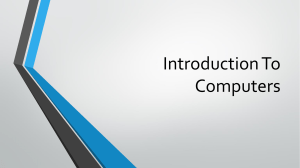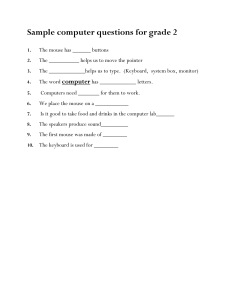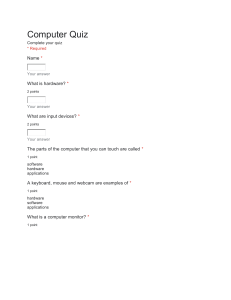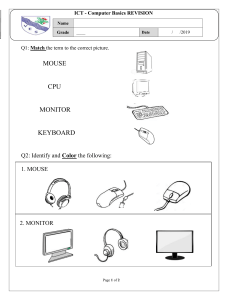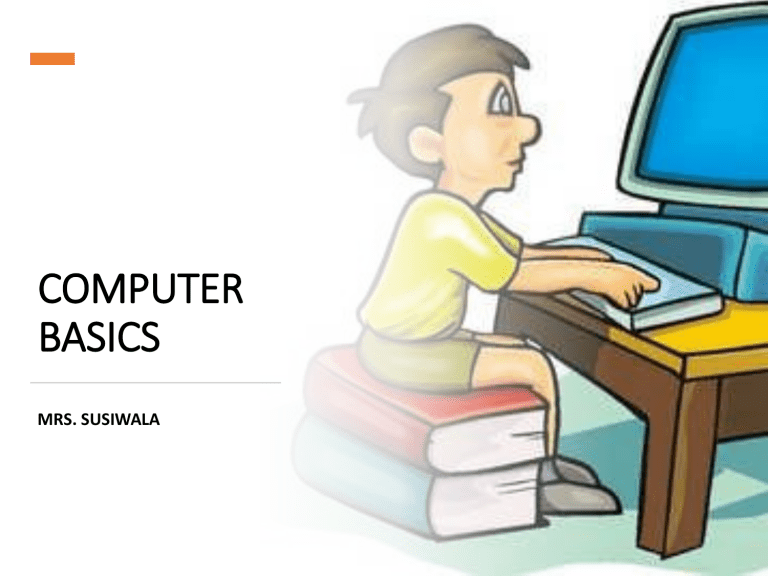
COMPUTER BASICS MRS. SUSIWALA Basic Understanding of Computers MICROPROCESSORS -- THE BRAIN OF THE COMPUTER PCs primarily use microprocessors (sometimes called the chip). The CPU (Central Processing Unit) is normally an Intel Pentium (or equivalent) and it is one of the most important components within your computer. COMPUTER SYSTEMS WHAT IS A COMPUTER? ❑ An electronic device that stores, accesses, and processes data, and can be programmed with instructions. ❑ A computer is made up of hardware and software, and can exist in many different sizes and set-ups. TYPES OF COMPUTERS Mini mainframe and Supercomputers • Very powerful, used by large organizations such an banks to control the entire business operation. Very expensive! Personal Computers • Cheap and easy to use. Often used as standalone computers or in a network. May be connected to large mainframe computers within big companies. THE FOUR FUNCTIONS OF A COMPUTER Function What Does It Do? Input Accepts data Processing Processes data Output Produces output Storage Stores results Computer Hardware Functions Input Devices Memory RAM ROM Central Processing Unit Output Devices Secondary Storage Devices General Understanding of how Computers Work Input Processing The computer collects information or instructions from you. You can provide the computer with input from devices such as a keyboard, a mouse, a stylus, webcam, or by speaking into a microphone. The computer interprets and processes the data you have inputted. It adds, multiplies, divides, finds, or manipulate data or text to complete a task you have given it. Output The computer produces information that has been processed. The output might be something you see on the screen (such as an answer to a mathematical problem), something you hear (such as that “ding” when you have made an error), or something you ask the computer to print. Storage The computer saves-stores-information or instructions in it’s memory Peripheral Devices HARDWARE & SOFTWARE Hardware refers to the physical components of your computer. • Examples include mouse, keyboard, monitor etc. The software is the instructions that makes the computer work. (You can not touch) Examples include Systems software and Application software. SOFTWARE • Software - set of electronic instructions that tell a computer what to do. • Example: • System software • Operating system software • Application software • Microsoft • Word, Excel, PowerPoint, • Publisher and Access • Google • Docs, Sheets, Slides, Sites, Application Software - Google Chrome Sites INPUT AND OUTPUT DEVICES Input Devices – Tells the computer what to do . Things you use to put information into the computer Examples of input devices are: • A keyboard • mouse • joysticks Output Devices -- “how the computer shows you what it's done” Everything you use to get information out. Examples of output devices are: • The monitor (the screen) is how the computer sends information back to you. A printer is also an output device. INPUT DEVICES ▪ The Mouse • Used to ‘drive’ Microsoft Windows ▪ The Keyboard • The keyboard is still the commonest way of entering information into a computer ▪ Tracker Balls • an alternative to the traditional mouse and often used by graphic designers INPUT DEVICES • Scanners A scanner allows you to scan printed material and convert it into a file format that may be used within the PC • Touch Pads A device that lays on the desktop and responds to pressure • Light Pens Used to allow users to point to areas on a screen • Joysticks Many games require a joystick for the proper playing of the game OUTPUT DEVICES OUTPUT DEVICES • Monitor • The computer screen is used for outputting information in an understandable format • Printers • There are many different types of printers. • In large organizations laser printers are most used due to the fact that they can print very fast and give a very high-quality output. OUTPUT DEVICES OUTPUT DEVICES • Speakers • Enhances the value of educational and presentation products. • Webcams • Headphones MEMORY Storage Devices – How the computer saves data and programs: ✔ Hard disk drives are an internal, higher capacity drive which also stores the operating system which runs when you power on the computer. ✔ USB allow you to save work take the data with you. MEMORY RAM RANDOM ACCESS MEMORY RAM - Random Access Memory The main 'working' memory used by the computer. ROM – Read Only Memory as the name suggests is a special type of memory chip that holds software that can be read but not written to. V ROM READ ONLY MEMORY STORES INFORMATION FOR A SHORT TIME STORES INFORMATION PERMANENTLY DATA CAN BE CHANGED INFORMATION INSIDE CAN NOT BE CHANGED DATA IS LOST WHEN THE DATA IS SAFE WHEN PC PC IS TURNED OFF IS SWITCHED OFF VERY FAST –BUY USES A FAST – BUT USES VERY LOT OF POWER LITTLE POWER. NOT PERMANENT PERMANENT How Computer Memory Is Measured ❑Bit All computers work on a binary numbering system, i.e. they process data in one's or zeros. This 1 or 0 level of storage is called a bit. ❑ Byte A byte consists of eight bits. ❑ Kilobyte A kilobyte (KB) consists of 1024 bytes. ❑ Megabyte A megabyte (MB) consists of 1024 kilobytes. ❑ Gigabyte A gigabyte (GB) consists of 1024 megabytes.
